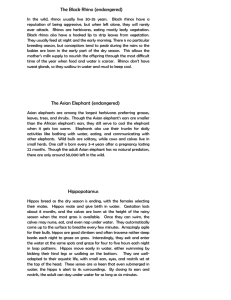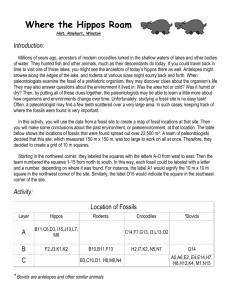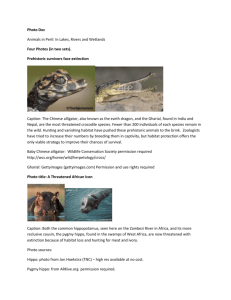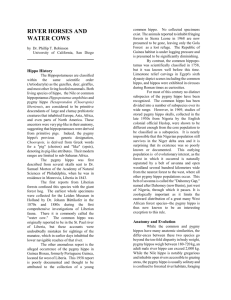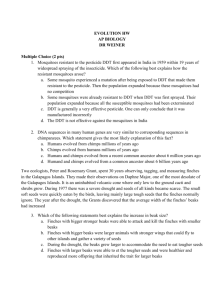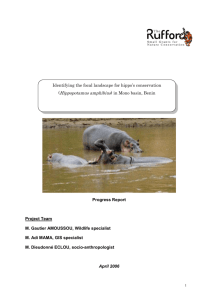There are two species of hippos in the world today – the Common
advertisement
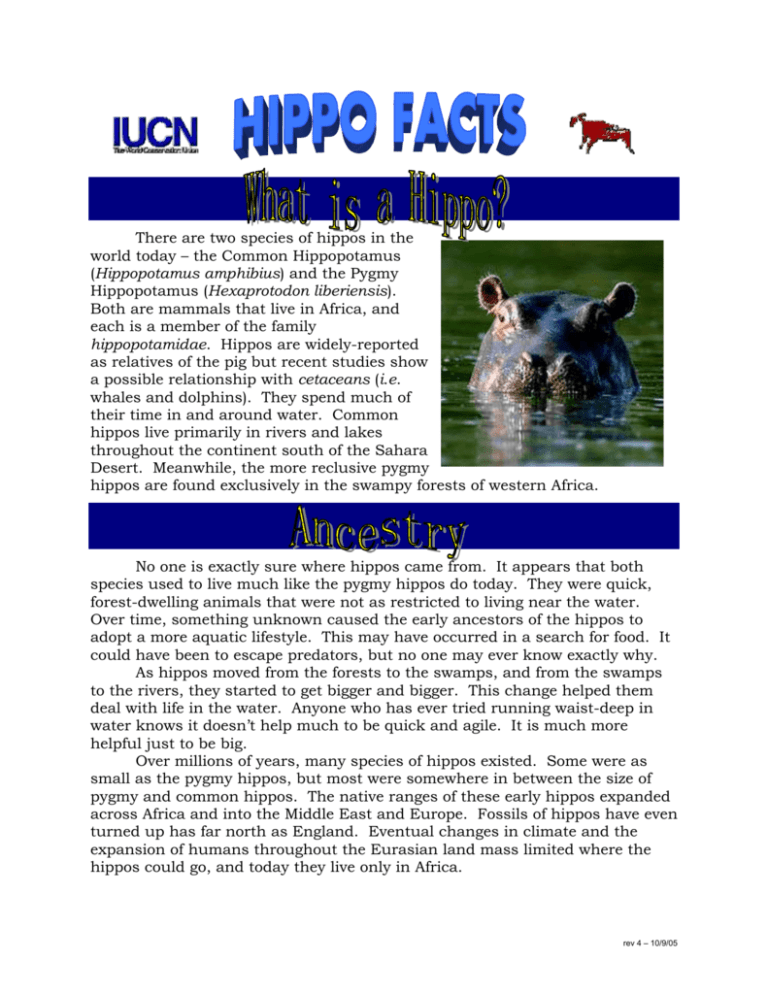
There are two species of hippos in the world today – the Common Hippopotamus (Hippopotamus amphibius) and the Pygmy Hippopotamus (Hexaprotodon liberiensis). Both are mammals that live in Africa, and each is a member of the family hippopotamidae. Hippos are widely-reported as relatives of the pig but recent studies show a possible relationship with cetaceans (i.e. whales and dolphins). They spend much of their time in and around water. Common hippos live primarily in rivers and lakes throughout the continent south of the Sahara Desert. Meanwhile, the more reclusive pygmy hippos are found exclusively in the swampy forests of western Africa. No one is exactly sure where hippos came from. It appears that both species used to live much like the pygmy hippos do today. They were quick, forest-dwelling animals that were not as restricted to living near the water. Over time, something unknown caused the early ancestors of the hippos to adopt a more aquatic lifestyle. This may have occurred in a search for food. It could have been to escape predators, but no one may ever know exactly why. As hippos moved from the forests to the swamps, and from the swamps to the rivers, they started to get bigger and bigger. This change helped them deal with life in the water. Anyone who has ever tried running waist-deep in water knows it doesn’t help much to be quick and agile. It is much more helpful just to be big. Over millions of years, many species of hippos existed. Some were as small as the pygmy hippos, but most were somewhere in between the size of pygmy and common hippos. The native ranges of these early hippos expanded across Africa and into the Middle East and Europe. Fossils of hippos have even turned up has far north as England. Eventual changes in climate and the expansion of humans throughout the Eurasian land mass limited where the hippos could go, and today they live only in Africa. rev 4 – 10/9/05 Modern common hippos are tied with white rhinos as the second largest land mammal in the world after the elephants. Male common hippos weigh 2 to 3 tons and females are just slightly less. Their skin is a gray to brownish-red with pink areas around their ears and under their chin. They have very few hairs on their body, but do have stiff whiskers on their broad lips that feel like a broom and a small amount of fuzziness around the edges of their ears and on their tail. The common hippo’s eyes and nostrils are placed on top of its head so that it can see and breath without having to lift its head too high out of the water. Pygmy hippos look much like a miniature version of the common hippo, but there are some definite differences. Pygmy hippos have proportionally longer legs and their eyes and nostrils don’t extend above their heads. The longer legs are more helpful to run through the dense forests, and since pygmies spend less time in the water, elevated eyes and nostrils aren’t really needed. When full grown, a pygmy hippo will usually weigh between 400 and 600 pounds. One of the most attentiongrabbing physical characteristics of both the common and pygmy hippo is their teeth. The canine and incisor teeth of both hippos are enormous and grow continuously throughout their lives. In some male common hippos, the canines may appear over 18 inches long! When either species of hippo wants to give a warning it just opens its cavernous mouth in a mighty yawn and gives a fearsome, toothy display. rev 4 – 10/9/05 The social organization of common and pygmy hippos is very different. Common hippos are quite “gregarious” (meaning they like to hang out together). Groups of more than 200 hippos have been seen, but herds of 10 to 20 are more typical. Many combinations of hippos occur, but a few general rules will usually apply. Herds of hippos generally consist of a dominant male, younger subordinate males, and females with their offspring. The young hippos are sometimes seen together in groups being supervised by an adult female while their mothers are feeding or breeding. One full-grown male hippo controls a territory. The territory is made up of slow moving water in a river or lake and piece of shoreline usually 50 to 100 yards across. The male allows other hippos to live on his territory. He is most interested with attracting females so that he may breed. Other male hippos may also live in the territory if they behave submissively and don’t attempt to breed with any females who might also be there. Occasionally, a small group of young males who are not old enough or large enough to hold a territory will gather in a less desirable part of the river and create a bachelor herd. Hippos spend most of the day living with the herd in the water or on the beach. At night they leave the shoreline and move inland to feed. Hippos are grazers; in one night a hippo may eat 100 lbs of grass! When food gets short in the dry season, they have also been known to raid the gardens of African farmers. Pygmy hippos are much more solitary, but occasionally, a breeding pair or a mother with a calf is seen. Pygmy hippos spend much of their day sleeping. They come out at night in search of roots, shoots, and leaves to eat. In order to get from place to place, they create trails that resemble tunnels through the dense underbrush of the forest. It appears that these trails may be shared by different pygmy hippos, but there is little interaction between them. rev 4 – 10/9/05 Currently, somewhere between 125,000 and 148,000 common hippos are believed to exist across more than 29 countries of sub-Saharan Africa. This is only about 1/3 the number of elephants living on the continent. Major threats to hippo survival are poaching and loss of habitat. Common hippos have now been recognized as a species Vulnerable to extinction by the IUCN. No more than 3,000 pygmy hippos are believed to remain in western Africa, with the majority living in Liberia. There have probably never been many pygmy hippos, but due to various threats, including deforestation, oil pollution, and hunting for meat and trophies, pygmy hippos are now recognized as Endangered. Eurasia: (yoo rā’ shə) Europe and Asia considered as one continent. Grazer: (grā’ zər) An animal that eats mainly grass. Gregarious: (gri gâr’ē əs) Sociable; Enjoys the company of others; Lives in flocks or herds. The opposite of “solitary.” Habitat: (hab’i tat’) The natural environment of an animal. Mammals: (mam’əls) Any warm-blooded animal with a backbone, some hair on its body, and feeds its young with milk. Poaching: (pō’ ching) Illegal hunting of an animal. Ranges: (rān’jəs) The region over which a population or species is distributed. Solitary: (sol’i tār’ ē) An animal that does not live or travel in groups; living habitually alone. The opposite of “gregarious.” Species: (spē’ shēz) A group of individuals having some common characteristics or qualities; distinct sort or kind. Territory: (tār’i tôr’ē) The area that an animal defends against intruders, esp. of the same species. Underbrush: (un’dər brush’) Shrubs, saplings, low vines, etc., growing under the large trees in a forest. Vulnerable: (vul’nər ə bəl) Facing a high risk of extinction in the wild in the medium-term future1. Yawn: (yon) Opening the mouth very wide. When hippos do this, it is usually as a warning by showing off their enormous teeth. 1 IUCN Red List Categories (1994) IUCN Council, Gland, Switzerland rev 4 – 10/9/05
